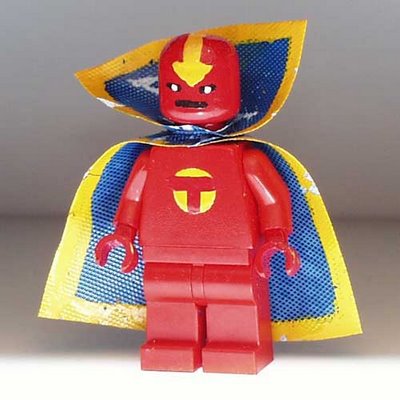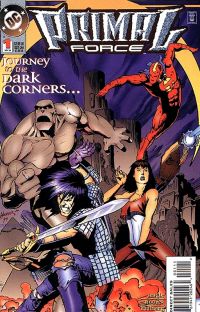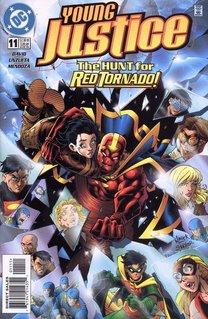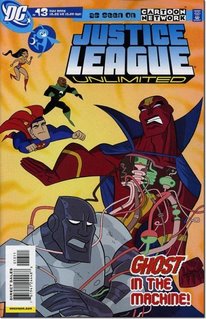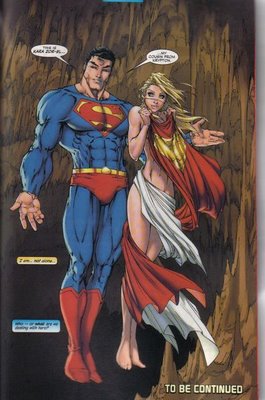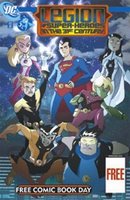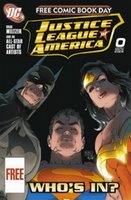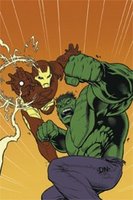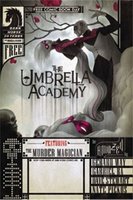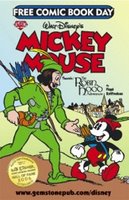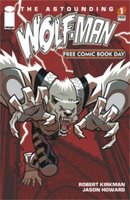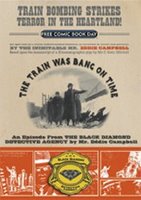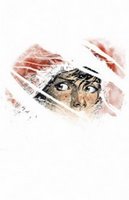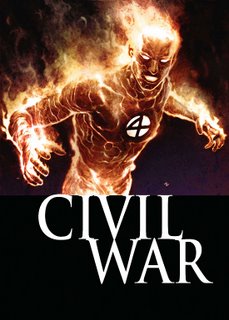
The cover of this week’s issue of Teen Titans seems incredibly symmetrical to me, probably because artist Tony S. Daniel made the line between the orange and navy halves of Deathstroke’s (snicker!) mask so straight. While the members of “Titans East” are sort of almost kinda positioned symmetrically, it’s that line on Deathstroke’s (heh!) mask that really seems to divide this image into two perfect halves.
Perhaps that’s what’s got me thinking in terms of two, easily divisible extremes, but as I was reading this issue, my mind kept leaping back and forth between excitement and disappointment, with each new detail being assigned a position in either the awesome or terrible category.
Let’s take a closer look, shall we?
First, the Awesome:
1.) Geoff Johns finally gets around to using some villains from the rogues galleries of some of the characters who have made up this version of the Teen Titans, namely Superboy clone Match and Impulse clone Inertia (unfortunately, he does this after he’s killed Superboy off and aged Impulse first into Kid Flash and then into Flash).
2.) Someone tries to make some sense out of Batgirl’s sudden and complete change in characterization between the end of her own series and the re-launch of Robin during the “One Year Later” initiative. Are you ready? Deathstroke (snort!) has been injecting her with some sort of drug that makes her evil. Now, is this a perfect solution? No. It explains why she’s evil (“Why do you think that Batgirl’s been acting rthe way she has?” ‘Stroke asks before administering an injection), and you could explain why she seemed to forget her own continuity (as evidenced here), her refusal to ever take another human life, what kind of clothes she liked to wear, why Robin kicked her ass so easy and why she was talking so eloquently (All side-effects of the serum!) Johns deserves a gold star, if not a gold medal, for this solution, but Adam Beechen still deserves derision for the original “Boy Wanted” story, as this doesn’t explain why Tim Drake thought Cassandra knew Navajo, why Batman is so blasé about a former sidekick who knows his secret identity running loose, why Oracle was so dumb that she took a police report that Batgirl was killed as the honest-to-God truth, or why Lynx came back to life all of a sudden for no reason. Still, way to go Johns! After this story arc, maybe DC will wise up and let Cassandra Cain recede into off-panel limbo, which is exactly the direction that Andersen Gabrych wrote her into at the end of Batgirl. (And no, I’m not reading Teen Titans when Beechen takes over. I read six issues of his Robin, and even after the Batgirl mess, it still really, really sucked, and showed the same lack of familiarity with the character. Teen Titans requires familiarity not only with Robin an Bat-history, but also about four or five other continuities on top of that).
3.) Lionmane makes an appearance. I love that dude’s name, and the fact that he’s a lion-man, but chose to go by “Lionmane” instead of “Lionman.”
4.) The “Titans East” Titans Tower looks pretty damn sweet.
5.) Johns’ Kid Devil, who is becoming the ultimate “foxhole Christian,” sneaking into mass and hanging out in the church rafters hoping God can save his soul from the devil he sold it to.
And now, the Terrible:
1.) Daniel’s art looks pretty good in single panels now and then, but he’s not a very good visual storyteller, a terrible “actor” with a pencil, and the story and art don’t match up as well as they should. Take the second panel, for example, in which Nightwing says goodbye to the Wilson kids while jumping off a roof. It’s a friendly parting of ways, but Nightwing looks grim and worried, and isn’t facing in their direction at all. He also has his little fighting sticks out…one has a weird hose near it, so maybe he shot a cable out of it, but I who the hell knows? He doesn’t look like an lifelong acrobat bidding a friendly farewell, he looks like a grim avenger of the night about to jump on the reader and buffet him or her about the face with his Daredevil sticks. There’s a certain Land-ishness to Daniel’s art, only it’s much, much, much more natural (which is a commentary on the lack of quality present in Land’s work, not the amount of quality in Daniels’).
2.) I give up, why is Match the Superboy-version of Bizarro now instead of, well, Match? Match was originally an exact clone of Superboy (albeit a blonde one) with a perfectly normal, not-backwards brain—he was sharp enough to impersonate Superboy and infiltrate Young Justice for a good long time. Here, we see that Match has the exact same haircut and taste in clothes that Superboy had right before his death (despite the fact that they haven’t had any interaction since Sins of Youth and, like the dark, mean Bizarro that Johns wrote in Infinite Crisis and Action Comics, Match has white crumbly skin, and talks in opposites. Oh, and he has a backwards “S” T shirt. What the fuck? Now that Superboy’s dead, think how much more interesting a Titans villain Match could have been. He could have easily claimed to have been the resurrected Superboy, and just about everyone would have believed him. Hell, in 52, Wonder Girl thought just about every new person she met was Superboy resurrected. Inertia explains that Match has been “rotting away little by little,” and that he’s “not much of a conversationalist anymore.” That’s Johns’ explanation for why Match is now Bizarroboy, but it’s just a way to force the dots to connect.
3.) Robin’s clothing collection is just goddam weird. Trying to clone Superboy back to life makes a certain amount of twisted sense, especially as the unhealthy reaction of a psychologically hurt young boy, but here Robin has a whole collection of the clothes of the loved ones he’s lost—his mom, his dad, Spoiler…was he planning on cloning them all?
4.) Deathstroke’s (hee hee!) explanation of his Evil Serum being responsible for Cassandra being bad comes too close on the heels of Robin’s accusation that ‘Stroke was driving Ravager mad by “pumping Rose full of the same serum that enhanced your strength and speed,” which makes one wonder if ‘Stroke was giving Cassie (and presumably Risk and Joker’s Daughter) the Slade Wilson super-serum and it was turning them crazy evil, or if that is an entirely different serum.
5.) When Inertia runs past Wonder Girl at super-speed, he mentions that her hair smells really nice. This is just a little thing, I know, and we are talking about a bunch of teenagers in skin-tight suits with super-powers, but must every villain these days be some kind of sex-pervert? Whatever happened to robbery, murder and ruling the world as villainous motivations?







